
A High Quality, Low Cost
|
By Chris |
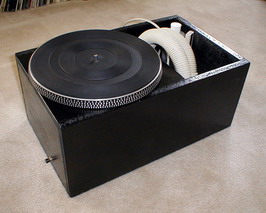 Build your own high quality, easy to use record cleaner. This design can be built for less than $50 and will remove at least as much grunge as the expensive VPI record cleaners. The original concept was developed by Jay Amble. |
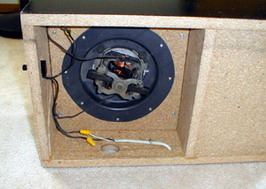 Here is a list of the parts for the record cleaner.
|
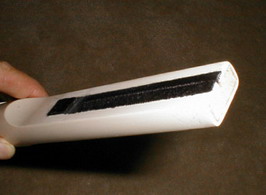 The vacuum cleaner may be used as is. I suggest removing the vacuum bag to improve suction. The small volume of liquid pulled from the records quickly evaporates so nothing needs to be done to trap it. In my case I wanted a one piece assembly so I dissembled the vacuum and embedded the vacuum motor into my record cleaner box. This also had the unexpected benefit of being considerably quieter. The turntable may also be used as is or it can be integrated into a record cleaner box as I have done. |
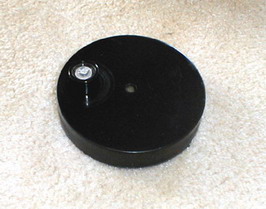 Next the crevice tool needs to be modified. Use a saw to square off the end of the crevice tool and then plug the end. I cut a thin piece of MDF to fit into the end and then glued it in place with 5 minute epoxy. Now cut a narrow slot into one side of the crevice tool. The slot should be about 3-3/4″ long and about 1/16″ wide. Extend the slot all the way to the end of the crevice tool to create a small opening at the end of the tool. This acts as a pressure relief and also maintains a minimum amount of air flow. Be sure that the slot is smooth and has no burrs. A hand held Dremel is ideal for cutting the slot. Line both sides of the slot with velvet. Velvet works better than felt since it retains less liquid. Contact cement works best for attaching the velvet. |
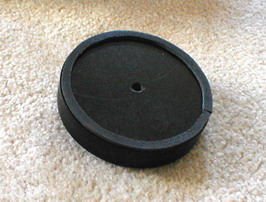 My record clamp is a 4″ circle cut from 3/4″ MDF but other materials could be used. A small plastic equipment foot from my junk bin was used to create a handle for spinning the record. The record clamp needs a rubber grip of some sort to turn the record while it is being vacuumed. A rubber O ring or rubber weather-stripping around the circumference of the clamp provides the needed traction and also keeps the cleaning fluid off of the record label. Having a good clamp makes the cleaning process much easier so don’t cut corners for this item. A threaded clamp would probably work even better for this application if you happen to have a threaded spindle. |
Cleaning Fluid
For the record cleaning fluid I use Laura Dearbon’s formula from her book “Good Sound”. There are a number of other formulas that could also be used. The following is quoted from Laura’s book (without permission, of course).
The safe formula is the same as archival commercial preparations, except that you are mixing it yourself and therefore it costs you a fraction of the price of ready mixed. It can be used for both hand and vacuum cleaning. It is a 25 percent solution of isopropyl alcohol in water, with a drop of
surfacant. Ethyl alcohol, sometimes applied to records in the form of vodka is more damaging to vinyl than is isopropyl. Use it only in an absolute pinch.
Drugstore isopropyl contains too many impurities to qualify it for record cleaning. Use technical or lab-grade isopropyl, which is extremely pure. Reagent grade is unnecessary and far more expensive. Water should be steam distilled, triple de-ionized. Both of these are readily available at a chemical supply house, which should sell them to you in pint and gallon sizes.
You also need to add a drop of surfacant, or wetting agent, to reduce the surface tension of the water so the formula can penetrate down into the grooves. Very high frequency grooves, in the range of 15 kHz, can be as small as four millionths of an inch, according to Wald Davies of LAST. Though alcohol itself helps somewhat, you still need a wetting agent. Two excellent and safe choices are Triton X-114 from Rohm-Haas and Monolan 2000 from Diamond Shamrock. Both of these are
nontoxic – but don’t take them internally – and biodegradable. Very importantly, they leave behind no residue on the record. They are harmless in these small amounts to record vinyl and, as far as is known, to any of the conceivable by-products and impurities likely to be found in record vinyl.
Kodak’s Kodaflow is sometimes recommended as a wetting agent. Do *not* use this as it contains chemicals in addition to surfacants that would leave behind residues bad for both record and stylus. Kodak recommends against this application.
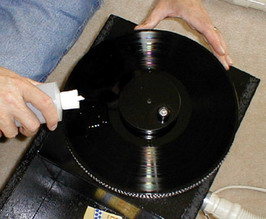 The first step in cleaning the record is putting a small portion of the cleaning fluid on the record surface. A puddle of fluid 2 inches around should be enough. You should use enough fluid to completely flood the surface of the record. |
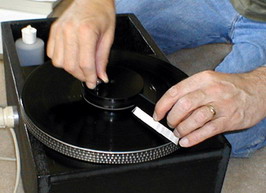 Turn the record clockwise about 10 turns while using the VPI record brush to distribute the cleaning fluid over the surface of the record and into the grooves. Repeat the above for another 10 turns while turning the record counter clockwise. |
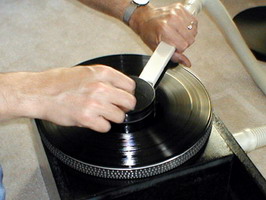 The last step is to vacuum the cleaning fluid from the record surface. Hold the crevice tool flat over the record and turn at least 10 turns. A couple of turns will remove all of the visible liquid but more turns are needed to get the last of the fluid out of the grooves. |
You must be logged in to post a comment.
Help us continue our work with a donation
18 queries. 0.340 seconds
September 15th, 2007 at 15:14
I made this rcm from these specs exactly. Im wondering if the vacuum crevice tool is supposed to touch the record when vacuuming? Of course I have the velvet applied to the crevice tool. It is a little tough to hold the vacuum close to the record without hitting it or being too far away and not sucking any liquid. Any info would be appreciated,thanks.
January 7th, 2008 at 23:33
Where can i found the vacuum accesories??? any website to buy these accesories?
Thanks